Abstract
19F NMR indicators have been used to measure the free cytosolic cation concentrations ([Mn+]i, where M is the atomic symbol and n is the value of the charge) of Ca2+, H+, and Mg2+ in perfused ferret hearts. The [Ca2+]i transient, cytosolic pH (pHi), and [Mg2+]i have also been followed at 16 phases in the cardiac cycle in hearts paced at 1.25 Hz at 30 degrees C. The initial [Ca2+]i rose rapidly after a 50-ms delay, was maximal at greater than 1.5 microM after 150 ms, and declined thereafter to the initial concentration. In contrast, no significant changes in pHi (pH 7.03 +/- 0.08) or [Mg2+]i (1.2 +/- 0.1 mM) were detected in the cycle. A decrease in developed pressure when the [Ca2+]i indicator (but not the pHi or [Mg2+]i indicator) was loaded into hearts was substantially reversed by the addition of 50 microM ZnCl2 to the perfusion medium. The Zn2+ was taken up into the myoplasm and displaced Ca2+ bound to the indicator, a symmetrically substituted difluoro derivative of 1,2-bis(o-aminophenoxy)ethane-N,N,N',N'-tetraacetic acid (5FBAPTA), as evidenced by the appearance of the Zn-5FBAPTA resonance. The decrease in developed pressure caused by 5FBAPTA, therefore, may be due to its Ca2+ buffering effect on the myoplasm. By coloading hearts with the [Ca2+]i and pHi indicators, simultaneous measurement of several [Mn+]i was demonstrated, which should provide a useful addition to the methods available to monitor cardiac function and pharmacology.
Full text
PDF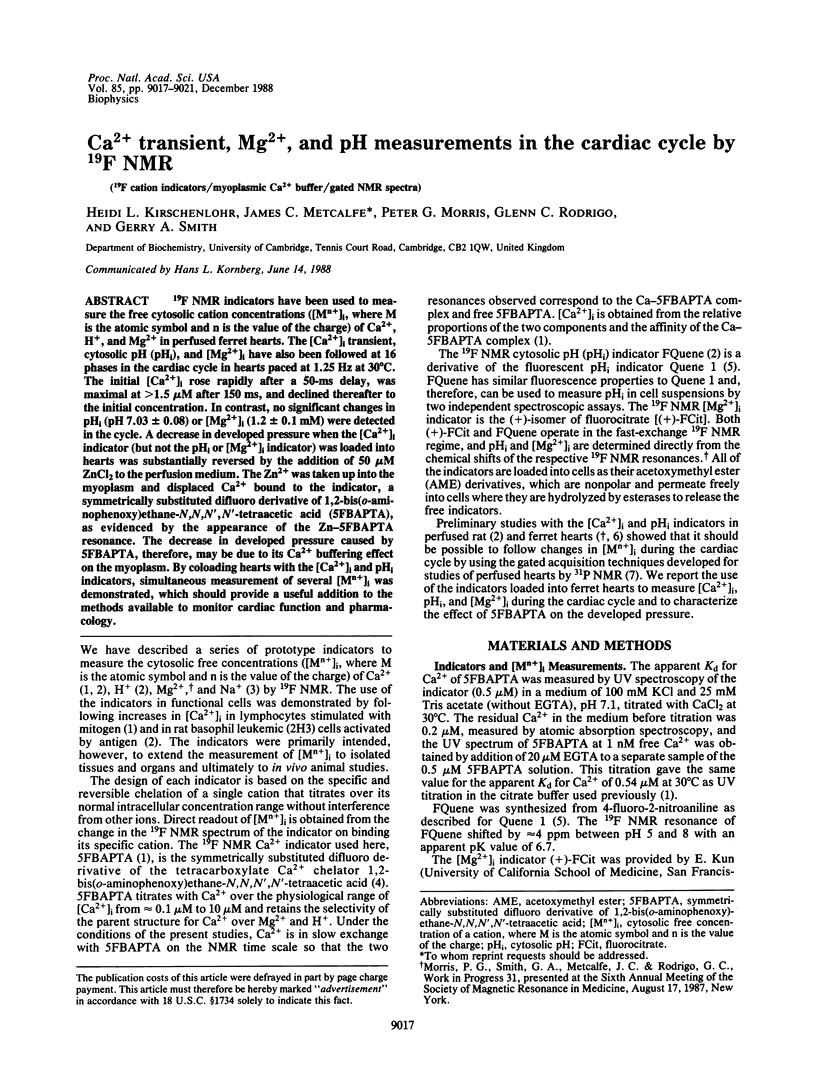
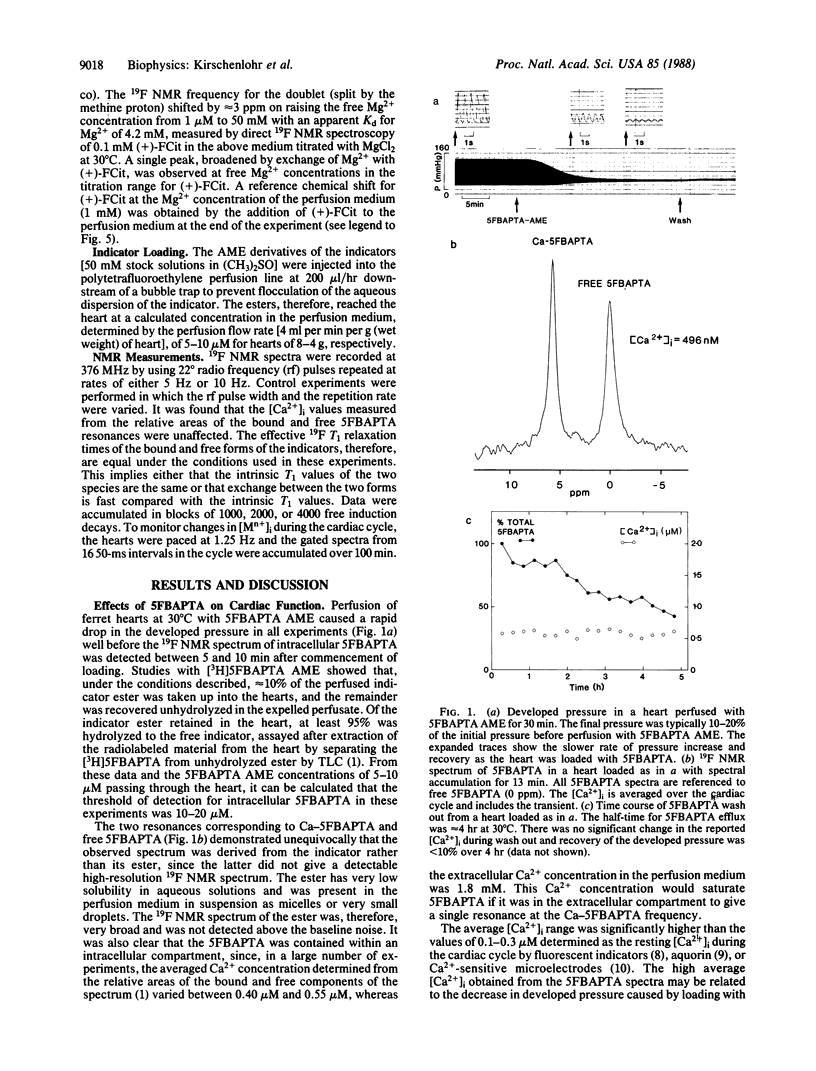
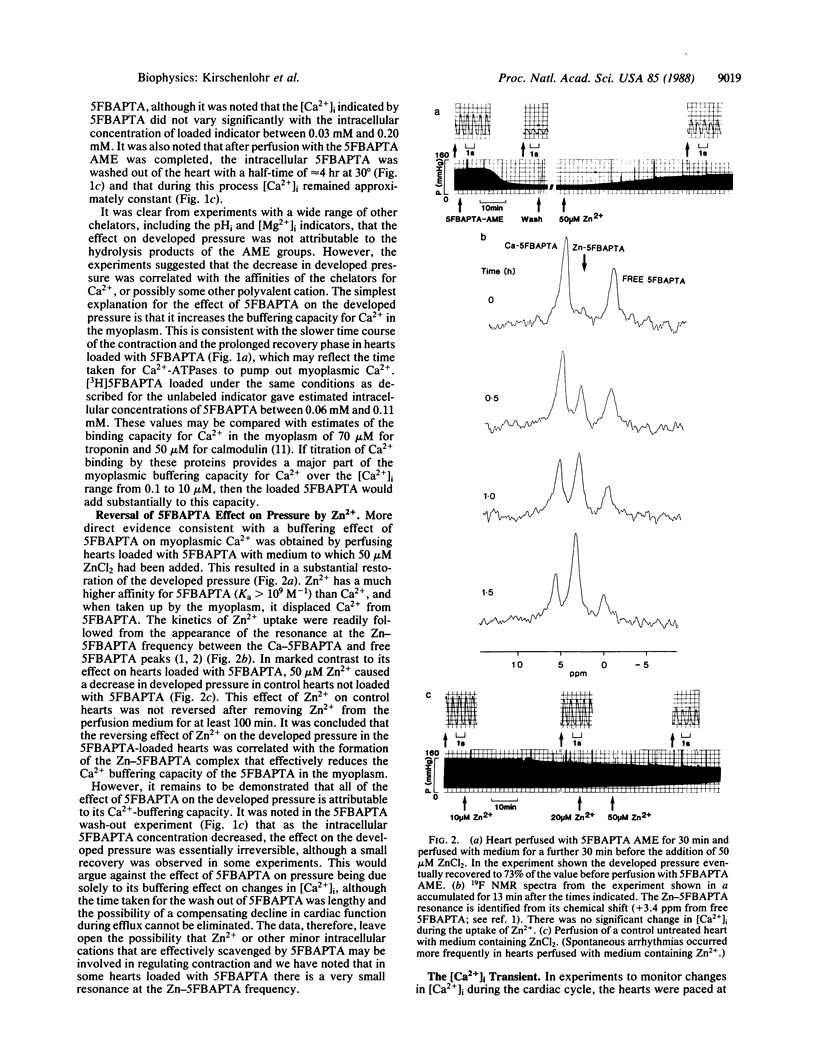
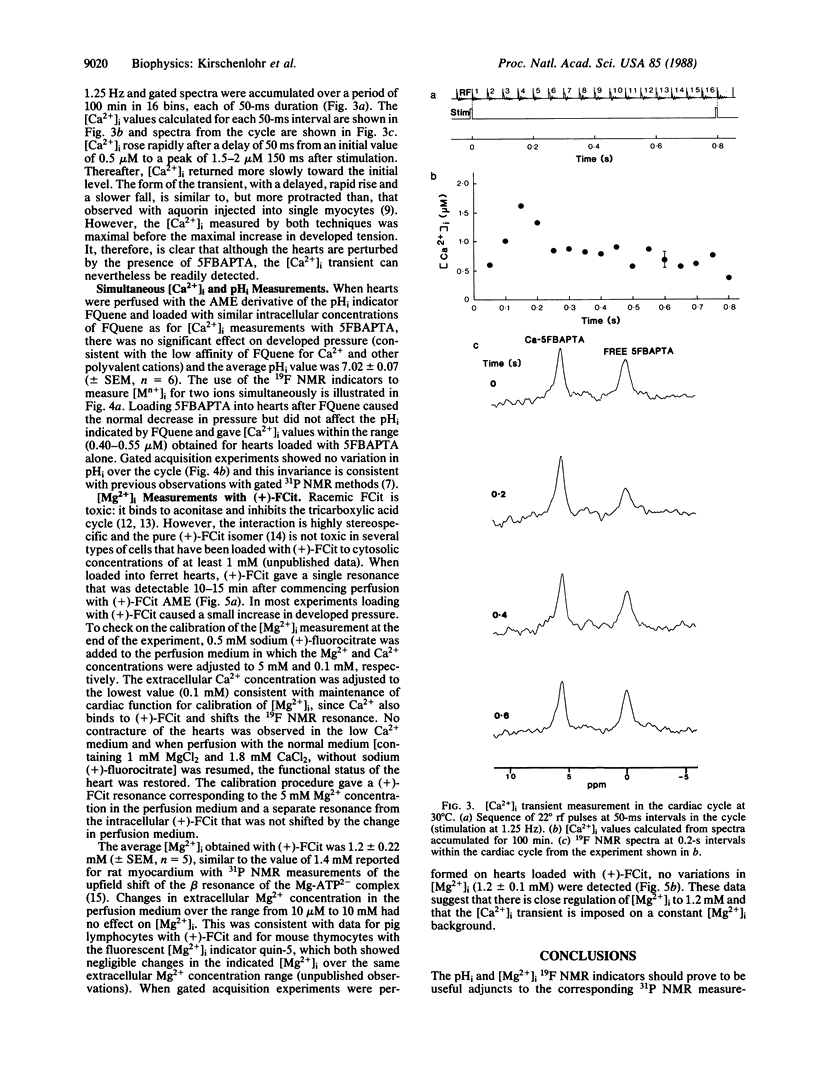
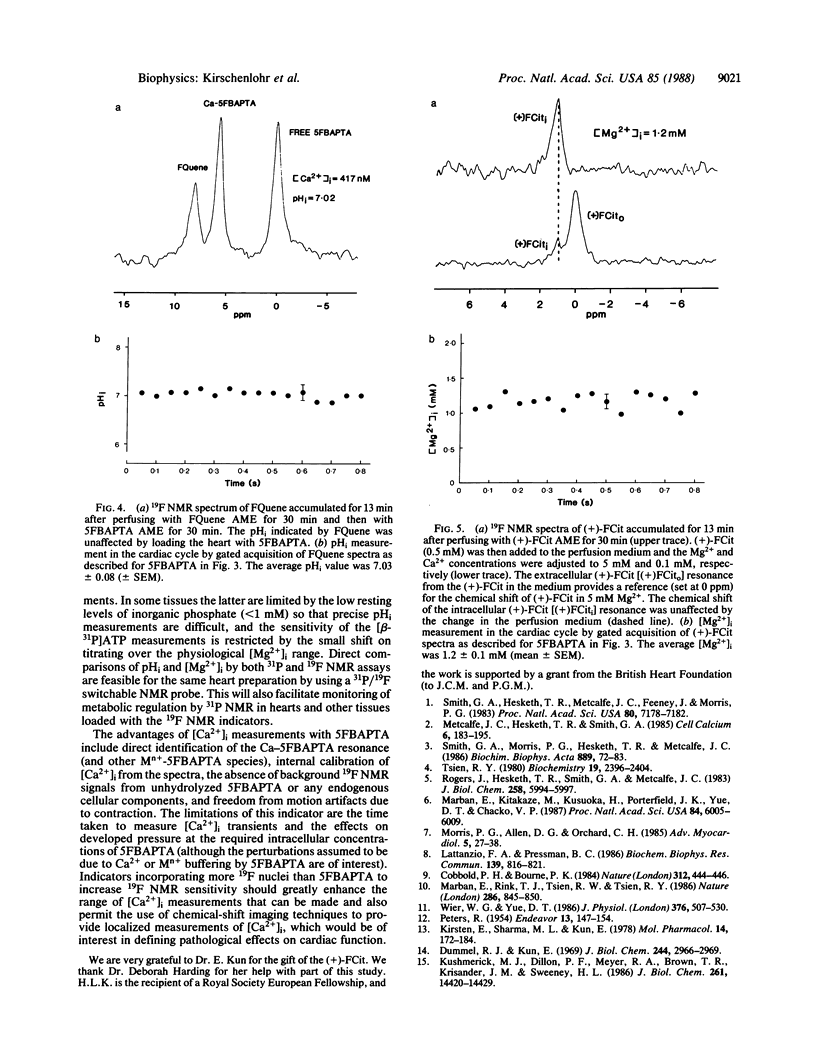
Images in this article
Selected References
These references are in PubMed. This may not be the complete list of references from this article.
- Cobbold P. H., Bourne P. K. Aequorin measurements of free calcium in single heart cells. 1984 Nov 29-Dec 5Nature. 312(5993):444–446. doi: 10.1038/312444a0. [DOI] [PubMed] [Google Scholar]
- Dummel R. J., Kun E. Studies with specific enzyme inhibitors. XII. Resolution of DL-erythro-fluorocitric acid into optically active isomers. J Biol Chem. 1969 Jun 10;244(11):2966–2969. [PubMed] [Google Scholar]
- Kirsten E., Sharma M. L., Kun E. Molecular toxicology of (-)-erythro-fluorocitrate: selective inhibition of citrate transport in mitochondria and the binding of fluorocitrate to mitochondrial proteins. Mol Pharmacol. 1978 Jan;14(1):172–184. [PubMed] [Google Scholar]
- Kushmerick M. J., Dillon P. F., Meyer R. A., Brown T. R., Krisanda J. M., Sweeney H. L. 31P NMR spectroscopy, chemical analysis, and free Mg2+ of rabbit bladder and uterine smooth muscle. J Biol Chem. 1986 Nov 5;261(31):14420–14429. [PubMed] [Google Scholar]
- Lattanzio F. A., Jr, Pressman B. C. Alterations in intracellular calcium activity and contractility of isolated perfused rabbit hearts by ionophores and adrenergic agents. Biochem Biophys Res Commun. 1986 Sep 14;139(2):816–821. doi: 10.1016/s0006-291x(86)80063-8. [DOI] [PubMed] [Google Scholar]
- Marban E., Kitakaze M., Kusuoka H., Porterfield J. K., Yue D. T., Chacko V. P. Intracellular free calcium concentration measured with 19F NMR spectroscopy in intact ferret hearts. Proc Natl Acad Sci U S A. 1987 Aug;84(16):6005–6009. doi: 10.1073/pnas.84.16.6005. [DOI] [PMC free article] [PubMed] [Google Scholar]
- Marban E., Rink T. J., Tsien R. W., Tsien R. Y. Free calcium in heart muscle at rest and during contraction measured with Ca2+ -sensitive microelectrodes. Nature. 1980 Aug 28;286(5776):845–850. doi: 10.1038/286845a0. [DOI] [PubMed] [Google Scholar]
- Metcalfe J. C., Hesketh T. R., Smith G. A. Free cytosolic Ca2+ measurements with fluorine labelled indicators using 19FNMR. Cell Calcium. 1985 Apr;6(1-2):183–195. doi: 10.1016/0143-4160(85)90043-0. [DOI] [PubMed] [Google Scholar]
- Morris P. G., Allen D. G., Orchard C. H. High-time-resolution 31P NMR studies of the perfused ferret heart. Adv Myocardiol. 1985;5:27–37. doi: 10.1007/978-1-4757-1287-2_3. [DOI] [PubMed] [Google Scholar]
- Rogers J., Hesketh T. R., Smith G. A., Metcalfe J. C. Intracellular pH of stimulated thymocytes measured with a new fluorescent indicator. J Biol Chem. 1983 May 25;258(10):5994–5997. [PubMed] [Google Scholar]
- Smith G. A., Hesketh R. T., Metcalfe J. C., Feeney J., Morris P. G. Intracellular calcium measurements by 19F NMR of fluorine-labeled chelators. Proc Natl Acad Sci U S A. 1983 Dec;80(23):7178–7182. doi: 10.1073/pnas.80.23.7178. [DOI] [PMC free article] [PubMed] [Google Scholar]
- Smith G. A., Morris P. G., Hesketh T. R., Metcalfe J. C. Design of an indicator of intracellular free Na+ concentration using 19F-NMR. Biochim Biophys Acta. 1986 Oct 31;889(1):72–83. doi: 10.1016/0167-4889(86)90010-8. [DOI] [PubMed] [Google Scholar]
- Tsien R. Y. New calcium indicators and buffers with high selectivity against magnesium and protons: design, synthesis, and properties of prototype structures. Biochemistry. 1980 May 27;19(11):2396–2404. doi: 10.1021/bi00552a018. [DOI] [PubMed] [Google Scholar]
- Wier W. G., Yue D. T. Intracellular calcium transients underlying the short-term force-interval relationship in ferret ventricular myocardium. J Physiol. 1986 Jul;376:507–530. doi: 10.1113/jphysiol.1986.sp016167. [DOI] [PMC free article] [PubMed] [Google Scholar]



